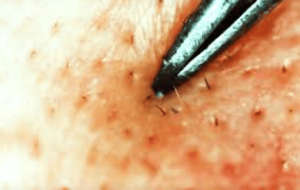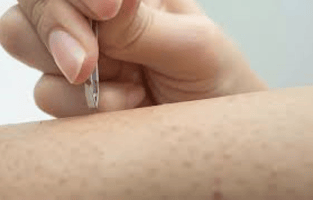Dealing with ingrown hairs and the scars they leave behind can be frustrating and uncomfortable. Whether they appear after shaving, waxing, or seemingly out of nowhere, ingrown hairs are a common skin concern that affects people of all skin types and tones.
The good news is that with the right approach and consistent care, you can effectively treat existing ingrown hairs, prevent new ones from forming, and reduce the appearance of any resulting scars.
This comprehensive guide will walk you through understanding the root causes of ingrown hairs, effective treatment methods for both active ingrown hairs and their resulting scars, and preventive measures to keep your skin smooth and clear moving forward.

Understanding Ingrown Hairs
It’s important to understand what causes these pesky skin issues in the first place. When hair curls back or grows sideways into the skin rather than coming out of the follicle, it is called an ingrown hair.
This happens most commonly after hair removal methods like shaving, waxing, or plucking, particularly in areas where hair is coarse and curly. People with curly or thick hair are more prone to ingrown hairs due to the natural tendency of the hair to curl back toward the skin.
Common areas affected by ingrown hairs include:
- Face and neck (particularly in men who shave)
- Armpits
- Legs
- Bikini area and pubic region
- Chest and back
When an ingrown hair develops, your body treats this hair as a foreign object, triggering an inflammatory response that results in the familiar symptoms:
- Redness around the affected follicle
- Swelling and tenderness
- Tiny, pimples projecting from the skin that could be pus-filled
- Itching or discomfort
- Hyperpigmentation in the affected area
If left untreated, ingrown hairs can become infected, leading to more serious issues like folliculitis or even scarring.
Treating Active Ingrown Hairs
When addressing the question of how to get rid of ingrown hairs and scars, it’s best to start with active ingrown hairs before they have a chance to create scarring:
Warm Compresses
Applying a warm, damp cloth to the affected area for 5-10 minutes several times a day can help soften the skin and reduce inflammation. The heat helps to bring the ingrown hair closer to the surface, making it easier to remove.
Gentle Exfoliation
Regular exfoliation is crucial for preventing and treating ingrown hairs. By removing dead skin cells, you help the hair break through the surface instead of becoming trapped beneath the skin.
- Use a gentle chemical exfoliant containing salicylic acid or glycolic acid
- Try a soft washcloth or exfoliating brush in circular motions
- Avoid harsh scrubs that can further irritate the skin
Topical Products
Several over-the-counter products are specifically designed to address ingrown hairs:
- Products containing benzoyl peroxide to reduce inflammation
- Salicylic acid treatments to exfoliate and reduce redness
- Tea tree oil formulations for their antimicrobial properties
- Hydrocortisone cream for temporary relief from itching and irritation
Manual Removal
While experts generally discourage ‘digging’for ingrown hairs, there are some safe ways to remove them once they’re visible near the surface:
- Use alcohol to sterilize a pair of tweezers.
- Use the tweezers to gently lift the hair above the skin surface—don’t pluck it out
- Apply an antiseptic afterward to prevent infection
 When to See a Dermatologist
When to See a Dermatologist
Some ingrown hairs require professional intervention, especially if:
- The area is severely inflamed or infected
- Multiple ingrown hairs form a larger bump or cyst
- The ingrown hair doesn’t respond to home treatment after a week
- You notice spreading redness or warmth (signs of infection)
Dermatologists can extract difficult ingrown hairs safely and prescribe topical antibiotics if infection is present.
Treating Ingrown Hair Scars
Addressing how to get rid of ingrown hairs and scars means understanding that scarring comes in different forms. Ingrown hairs can lead to several types of scarring:
Hyperpigmentation
This is the most common form of scarring from ingrown hairs, especially in people with darker skin tones. It appears as darkened patches where ingrown hairs were present.
- Use products containing vitamin C to brighten dark spots
- Apply alpha hydroxy acids (AHAs) to gently exfoliate and fade marks
- Consider products with niacinamide, which has been shown to reduce hyperpigmentation
- Always use sunscreen, as sun exposure can worsen hyperpigmentation
Post-Inflammatory Erythema
These are red or purple marks that remain after the ingrown hair resolves. They’re more common in fair skin and can take months to fade.
- Products with centella asiatica or green tea can help reduce redness
- Azelaic acid treatments may speed healing
- LED red light therapy can help minimize inflammation
Textured Scarring
In more severe cases, ingrown hairs can cause indented scars or raised keloid scars, which require more intensive treatment.
- Retinoids can help improve the appearance of shallow scars over time
- Professional treatments like microneedling stimulate collagen production
- Laser treatments can be effective for both raised and indented scars
- Chemical peels can lessen scarring and enhance skin texture.
Professional Scar Treatments
For persistent or severe scarring, dermatologist-administered treatments can be very effective:
- Chemical peels for superficial scarring
- Microdermabrasion to improve skin texture
- Laser therapy to reduce pigmentation and stimulate collagen
- Corticosteroid injections for keloid or hypertrophic scars
When considering how to get rid of ingrown hairs and scars through professional means, consult with a board-certified dermatologist who can recommend the best approach for your specific skin type and concerns.
Prevention Strategies
The best approach to how to get rid of ingrown hairs and scars is prevention. Include the following in your daily routine:
Proper Hair Removal Techniques
- Shave in the direction of the hair comes out from skin rather than against it.
- Use a clean, sharp razor and change the blades often
- Apply shaving cream or gel to provide lubrication
- Consider switching to an electric razor, which may cause fewer ingrown hairs
- If waxing, ensure the wax is applied and removed properly
Pre and Post Hair Removal Care
- Exfoliate the area gently 24-48 hours before hair removal
- Apply warm water before shaving to soften the hair
- Use post-shave products containing witch hazel or tea tree oil
- Apply a cool compress after hair removal to reduce inflammation
- Moisturize regularly to keep skin hydrated and supple

Alternative Hair Removal Methods
If you’re particularly prone to ingrown hairs, consider:
- Depilatory creams (though test for skin sensitivity first)
- Laser hair removal for permanent reduction
- Electrolysis for permanent hair removal
Daily Skin Care Habits
- Establish a consistent exfoliation routine (2-3 times weekly)
- Use non-comedogenic moisturizers that won’t clog pores
- Wear loose-fitting clothing in areas prone to ingrown hairs
- Apply sunscreen daily to prevent darkening of scars
- Consider using body lotions with mild chemical exfoliants
Natural Remedies
Many people seeking information on how to get rid of ingrown hairs and scars prefer natural approaches. Here are some effective home remedies:
Sugar Scrub
- Combine equal amounts of sugar and coconut or olive oil.
- Gently massage onto dampened skin in circular motions
- Rinse thoroughly and pat dry
- Use 1-2 times weekly for prevention
Tea Tree Oil
- Dilute tea tree oil with a carrier oil (1-2 drops per tablespoon)
- Use a cotton swab to apply to the regions of the body affected.
- Contains natural antimicrobial properties to prevent infection
Aloe Vera
- Pure aloe vera gel can be applied to reduce irritation.
- Helps reduce redness and promote healing
- It is safe for daily usage.
Apple Cider Vinegar
- Dilute with equal parts water
- To aid in exfoliation and irritation reduction, apply with a cotton ball.
- Use once daily after cleansing
Honey and Aspirin Mask
- Crush 2-3 uncoated aspirin tablets and mix with a teaspoon of honey
- Apply for ten to fifteen minutes to the regions of the skin affected.
- The salicylic acid in aspirin provides gentle exfoliation
Special Considerations for Different Body Areas
How to get rid of ingrown hairs and scars may vary depending on the area affected:
Facial Area
- Use gentler products specifically formulated for facial skin
- Consider single-blade razors or safety razors for shaving
- Apply non-comedogenic moisturizers afterward
Bikini Area
- Consider trimming hair instead of complete removal
- Use dedicated bikini-area products that address the sensitive skin
- To lessen friction, put on loose cotton underwear.

Legs and Arms
- Exfoliate regularly in the shower with a body scrub or exfoliating mitt
- Moisturize immediately after showering while skin is still damp
- Consider dry brushing as part of your routine
FAQs
Can ingrown hair scars be permanently removed?
While complete removal isn’t always possible, most ingrown hair scars can be significantly improved with consistent treatment. Hyperpigmentation typically fades over time with proper care, though deeper textured scars may require professional treatments like laser therapy or microneedling for optimal results.
The key is early intervention—treating ingrown hairs promptly reduces the likelihood of permanent scarring.
What is the duration required for the fading of ingrown hair scars?
The healing time for ingrown hair scars varies based on several factors including scar type, skin tone, and treatment approach. Hyperpigmentation may begin to fade within 3-6 months with consistent use of brightening ingredients and sun protection.
Post-inflammatory erythema (redness) typically improves within 1-3 months. Textured scarring takes longer, often requiring 6-12 months of targeted treatment to see significant improvement.
Do ingrown hairs always leave scars?
Not all ingrown hairs result in scarring. Factors that increase the risk of scarring include picking or squeezing the ingrown hair, bacterial infection, chronic inflammation, and individual skin susceptibility.
People with darker skin tones are more prone to post-inflammatory hyperpigmentation after ingrown hairs. Proper treatment of active ingrown hairs significantly reduces the risk of scarring.
Can I treat ingrown hairs and scars if I have sensitive skin?
Yes, but you’ll need to take extra precautions. For sensitive skin, focus on gentle approaches: mild chemical exfoliants (like PHA rather than BHA), fragrance-free products, and patch testing new products.
Natural remedies like diluted tea tree oil or aloe vera are often well-tolerated. Start with lower concentrations of active ingredients and gradually increase as your skin adjusts. If irritation occurs, consult with a dermatologist for sensitive skin-friendly alternatives.
Is it better to treat ingrown hairs when wet or dry?
Treating ingrown hairs is most effective when the skin is slightly damp or after a warm shower, as this softens the skin and hair, making extraction easier if necessary. Apply warm compresses to bring the hair closer to the surface.
However, exfoliation can be performed on either dry or damp skin, depending on the product formulation—dry brushing works on dry skin, while scrubs and chemical exfoliants are typically applied to damp skin. Always follow with moisturizer to maintain skin barrier health.
Conclusion…
Finding effective solutions for how to get rid of ingrown hairs and scars requires a multi-faceted approach that combines prevention, active treatment, and patience. By understanding the causes of ingrown hairs and implementing the proper techniques for hair removal and skin care, you can significantly reduce their occurrence.
For existing scars, consistent use of targeted treatments like chemical exfoliants, vitamin C, and niacinamide can gradually improve their appearance. What works for one person may not work for another, so don’t be discouraged if you need to try several approaches before finding your ideal solution.
For persistent or severe cases of ingrown hairs and scarring, consulting with a dermatologist can provide additional treatment options tailored to your specific needs.



